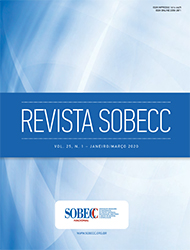Professional satisfaction of nurses at a surgicenter in an excellence hospital
DOI:
https://doi.org/10.5327/Z1414-4425202000010006Keywords:
Centro cirúrgico, Centro de material e esterilizaçãoAbstract
Objectives: To analyze and compare the professional satisfaction index (PSI) of surgical block (SB) nurses. Method: Comparative and quantitative field study that used the PSI in the evaluation of autonomy, interaction, compensation, organizational standards, professional status and work requirements of nurses working in the SB of a private hospital in São Paulo. Results: Of the 49 nurses in the sample, 39 worked in the operating room (OR) and post-anesthesia recovery room (PARR) and 10 worked in the material and sterilization center (MSC). Interaction was the most important component, and professional status was the least important. However, professional status obtained the highest level of satisfaction, while work requirements received the lowest. The PSI was 11.04 (low level), considering possible variation between 0.9 and 37.1. There was a significant difference for interaction, with greater satisfaction of OR/PARR nurses compared to MSC nurses. Conclusion: Professional satisfaction of SB nurses assessed by PSI was low. It is important to have knowledge of the factors that influence this index, as satisfaction directly interferes in the quality of care and prevents occupational diseases, besides being an indicator of results in the work process.References
Siqueira VT, Kurcgant P. Satisfação no trabalho: indicador de qualidade no gerenciamento de recursos humanos em enfermagem. Rev Esc Enferm USP. 2012;46(1):151-7.
Chaves LD, Ramos LH, de Figueiredo EN. Satisfação profissional de enfermeiros do trabalho no Brasil. Acta Paul Enferm. 2011;24(4):507-13.
Korompeli A, Muurlink O, Tzavara C, Velonakis E, Lemonidou C, Sourtzi P. Influence of shiftwork on greek nursing personnel. Saf Health Work [Internet]. 2014 [cited 2017 Aug 1]; 5(2):73-9. Available at: ttp://www.ncbi.nlm.nih.gov/pmc/articles/PMC4147231/ pdf/main.pdf
Navarro VL, Padilha V. Dilemas do trabalho no capitalismo contemporâneo. Psicol Soc. 2007;19(1):14-20.
Veiga KC, Fernandes JD, Paiva MS. Análise fatorial de correspondência das representações sociais sobre o trabalho noturno da enfermeira. Rev Bras Enferm. 2013;66(1):18-24.
Barbosa LR. Relações entre liderança, motivação e qualidade na assistência de enfermagem: revisão integrativa da literatura. [dissertação]. [Ribeirão Preto]: Universidade de São Paulo, Escola de Enfermagem de Ribeirão Preto. Ribeirão Preto (SP); 2007. 139f.
Ferreira EM, Possari JF, Moderno AMB. Fatores de satisfação e profissional do enfermeiro d de um hospital universitário insatisfação e centro cirúrgico de grande porte. Rev SOBECC 2006; 11(2):15-26.
Lino MM. Satisfação profissional entre enfermeiras de UTI. [dissertação de mestrado]. [São Paulo]. Universidade de São Paulo, Escola de Enfermagem. São Paulo; 1999. 236f.
Campos RM. Satisfação da equipe de enfermagem do serviço de atendimento móvel às urgências (SAMU) no ambiente de trabalho. [dissertação]. [Natal]. Universidade Federal do Rio Grande do Norte, Centro de Ciência da Saúde; 2005. 193f.
Monteiro AL, dos Santos AD, de Macedo IP, Gurgel PK, Cavalcante JM. A expressão da autonomia do enfermeiro no acompanhamento do crescimento e desenvolvimento da criança. Rev Enferm UERJ. 2011;19(3):426-31.
Stumm EM, Maçalai RT, Kirchner RM. Dificuldades enfrentadas por enfermeiros em um centro cirúrgico. Texto Contexto Enferm. 2006;15(3):464-71.
Lima L, Pires DEP, Forte ECN, Medeiros F. Satisfação e insatisfação no trabalho de profissionais de saúde da atenção básica. Rev Esc Anna Nery 2014 [citado 2017 Aug 1]; 18(1):17-24. Disponível em: http://www.scielo.br/pdf/ean/v18n1/1414-8145-ean-18-01-0017.pdf
Paiva FF, de Mattia Rocha A, Cardoso LD. Satisfação profissional entre enfermeiros que atuam na assistência domiciliar. Rev Esc Enferm USP. 2011;45(6):1452-8.
Hanson LLM, Töres T, Oxenstierna G,Hyde M, Westerlund H. Demand, control and social climate as predictors of emotional exhaustion symptoms in working Swedish men and women. Scand J Public Health 2008;36(7):737-43.
Sartoreto IS, Kurcgant P. Satisfação e insatisfação no trabalho do enfermeiro. Rev Bras Ciências da Saúde 2017; 21(2):181-8. DOI:10.4034/RBCS.2017.21.02.12
Lopes DFM, Silva A, Garanhani ML, Merighi MAB. Ser trabalhador de enfermagem da Unidade de Centro de Material: uma abordagem fenomenológica. Rev Esc Enferm USP 2007;41(4):675-82.
da Silva Florêncio ACU. O impacto do trabalho do centro de materiais na qualidade da assistência. Rev SOBECC 2011; 16(1):31-9.
Downloads
Published
How to Cite
Issue
Section
License
By publishing in Revista SOBECC, authors retain the copyright of their article and agree to license their work using a Creative Commons Attribution (CC BY 4.0) International Public License, thus accepting the terms of this license. The CC BY 4.0 license allows others to distribute, remix, adapt, and create from the published article, even for commercial purposes, provided they give due credit to the creators of the work (authors of the article).
The authors grant to Revista SOBECC the right of first publication, to identify itself as the original publisher, and grant to the journal a non-exclusive license to use the work in the following ways: (1) to sell and/or distribute the article in hard copies and/or in electronic format; (2) to distribute parts and/or the entire article in order to promote the journal through the internet and other digital and printed media; (3) to record and reproduce the article in any format, including digital media.
With this license, authors can enter into separate contracts for non-exclusive distribution of the article (e.g., publishing in an institutional repository or as a book chapter), with acknowledgement of authorship and initial publication in Revista SOBECC. Authors are encouraged to publish and distribute their work online after publication in the Revista SOBECC, as this can increase the article's visibility and impact.
In line with the journal's policies, each published article will be assigned a CC BY 4.0 license, which will be visible on the abstract page and in the PDF of each article with the respective link to the license terms.











